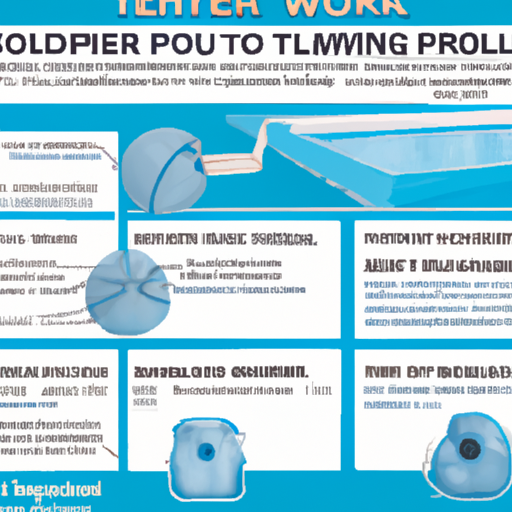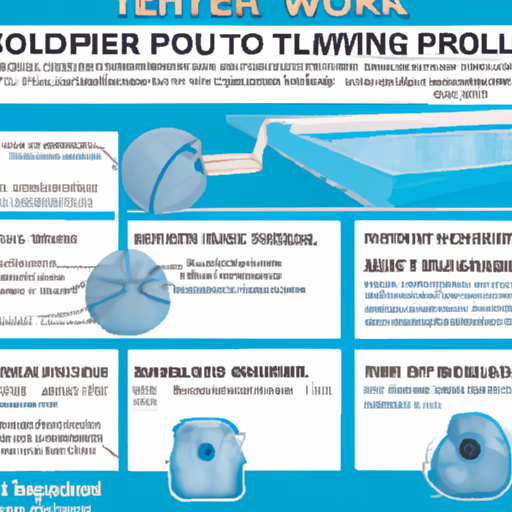So, you have a pool and the cold weather is approaching. You must be wondering how to properly prepare your pool for winter, right? Well, fear not! In this article, we will discuss the process for winterizing a pool in detail, so you can ensure that your pool remains in good condition during the winter months. Trust me, it’s not as complicated as it may seem.
First things first, you need to clean your pool thoroughly. This means removing any debris and giving it a good scrub. Nobody wants to start the winter with a dirty pool, right? Next, you’ll want to balance the water chemistry. This involves testing the water and adjusting the pH and alkalinity levels to the recommended ranges. Don’t worry, we’ll go into more detail about this in the article.
Once your pool is clean and the water chemistry is balanced, it’s time to lower the water level. This is done to prevent any potential damage caused by freezing and expanding water. You’ll also want to drain any water from the pool equipment, such as the pump and filter system. Again, we’ll provide you with step-by-step instructions on how to do this.
By following the process of winterizing your pool, you can ensure that it remains in good condition throughout the winter season. So, if you want to learn more about each step and get some expert tips, keep reading our article. Trust me, your pool will thank you for it! Winterizing your pool is an essential step to ensure its longevity and proper functioning throughout the winter season. By following a few simple steps, you can protect your pool from potential damage caused by freezing temperatures, debris buildup, and chemical imbalances. In this article, we will guide you through the process of winterizing your pool, from preparing the pool to maintaining it during the winter, and finally, opening it in the spring.

Preparing the Pool
Before you begin winterizing your pool, it’s important to prepare the pool by removing any accessories and cleaning it thoroughly. Start by removing any pool accessories such as ladders, diving boards, or slide attachments. These can be stored in a safe and dry place for the winter.
Next, clean the pool by removing any debris, leaves, or dirt that may have accumulated. Use a pool skimmer or a net to remove larger debris, and then brush the walls and floor of the pool to loosen any dirt or algae. Finally, vacuum the pool to ensure it is completely clean.
Once the pool is clean, it’s time to adjust the water chemistry. Test the pH, alkalinity, and chlorine levels of the water, and make any necessary adjustments to ensure they are within the recommended range. This will help prevent scale buildup, algae growth, and other water-related issues during the winter months.
Lowering the Water Level
Lowering the water level in your pool is an important step in the winterization process. This helps prevent the water from freezing and causing damage to the pool and its equipment. There are two common methods to lower the water level: draining excess water and using a pump.
If your pool has excessive water, you can drain it manually by attaching a garden hose to the pool’s drain valve and directing it away from the pool area. Make sure to monitor the water level closely and stop draining once it is at the desired level.
If draining manually is not feasible, you can use a pump to lower the water level. Attach the pump to a drain or a dedicated hose connection on your pool, and direct the water away from the pool area. Again, monitor the water level closely and stop pumping once it reaches the desired level.
It’s important to maintain the proper water level throughout the winter. Ideally, the water level should be below the skimmer or any other pool equipment. This will help protect the skimmer, pumps, filters, and other equipment from potential damage caused by freezing water.

Protecting Pool Equipment
To protect your pool equipment from freezing temperatures and potential damage during the winter, you need to remove and store certain items, drain plumbing lines, and cover the equipment.
Start by removing any pumps, filters, heaters, and other equipment from the pool. Clean and dry them thoroughly before storing them in a safe and dry place for the winter. This will help prevent any damage from freezing water or debris buildup.
Next, drain and blow out the plumbing lines to ensure there is no standing water left that can freeze and cause damage. Use a shop vac or an air compressor to blow out water from the pipes and fittings. Start at the furthest point from the pool and work your way back, making sure to include all plumbing lines, return lines, and drain lines.
Once the plumbing lines are drained, cover and secure the pool equipment. Use a cover or tarp to protect the equipment from debris, snow, and ice. Secure the cover properly to prevent it from blowing off during strong winds.
Winterizing Pool Plumbing
In addition to protecting the pool equipment, it’s important to winterize the pool plumbing to prevent freezing, cracking, and other damage. This involves adding winterizing chemicals, closing pool skimmer and return lines, and using plugs and gizmos for protection.
Start by adding winterizing chemicals to the pool water. These chemicals will help balance the water chemistry, prevent algae growth, and protect the pool surfaces during the winter. Follow the manufacturer’s instructions for dosage and application.
After adding the winterizing chemicals, close the pool skimmer and return lines to prevent any water from entering or exiting the pool. You can use winterizing plugs or gizmos to seal the lines and prevent freezing water from causing damage.
Once the skimmer and return lines are closed, you can also use plugs and gizmos to protect other pool features such as jets, lights, and drains. These plugs and gizmos help prevent water from freezing and causing damage to these components.

Installing a Winter Pool Cover
Installing a winter pool cover is crucial to protect your pool from debris, snow, and ice during the winter months. There are different types of covers available, such as mesh covers or solid covers. It’s important to choose the right type of cover based on your pool and climate conditions.
Before installing the cover, clean and dry the pool surface thoroughly. Remove any debris, leaves, or dirt that may have accumulated. Brush the walls and floor of the pool and vacuum any remaining debris.
Once the pool is clean, secure the winter cover properly. Use the provided anchors, straps, or clips to secure the cover tightly. This will prevent any debris or water from entering the pool and causing damage.
Winterizing the Pool Deck
While winterizing the pool itself is important, it’s also necessary to winterize the pool deck to ensure its longevity and functionality. This involves cleaning and removing debris, sealing cracks and joints, and protecting furniture and accessories.
Start by cleaning the pool deck thoroughly. Remove any leaves, dirt, or other debris that may have accumulated. Use a broom or a leaf blower to sweep the deck and a hose or pressure washer to remove any stubborn dirt or stains.
After cleaning, inspect the deck for any cracks or joints that may need sealing. Fill any cracks or gaps with a suitable sealant to prevent water from entering and causing further damage during freezing temperatures.
Finally, protect any furniture or accessories on the pool deck. Store them in a safe and dry place for the winter, or cover them with waterproof and weather-resistant covers. This will help extend their lifespan and prevent damage from snow, ice, or freezing temperatures.

Maintaining the Pool During Winter
Even though your pool may be closed for the winter, it still requires regular maintenance to ensure it remains in good condition. This includes removing debris from the cover, checking and maintaining water chemistry, and monitoring and adjusting the water level.
Regularly remove debris, leaves, or snow that may accumulate on the pool cover. Use a pool brush or leaf net to remove the debris without damaging the cover. This will help prevent excess weight and potential damage to the cover.
Check and maintain the water chemistry regularly throughout the winter. Test the pH, alkalinity, and chlorine levels, and make any necessary adjustments to ensure they are within the recommended range. This will help prevent scale buildup, algae growth, and other water-related issues.
Monitor the water level in your pool closely throughout the winter. If the water level drops too low, add water using a garden hose. If it rises too high, drain excess water using a pump or the pool’s drain valve. Maintaining the proper water level is crucial to prevent damage to the pool and its equipment.
Opening the Pool in Spring
When the winter season is over, it’s time to open your pool and prepare it for another season of swimming. Start by removing the winter cover carefully. Clean and dry the cover before storing it for the summer.
Next, clean and treat the pool water to ensure it is safe and ready for swimming. Remove any debris or leaves that may have accumulated on the pool surface, brush the walls and floor, and vacuum the pool. Test the water chemistry and make any necessary adjustments to balance the pH, alkalinity, and chlorine levels.
Reassemble and test the pool equipment before you start using the pool. Install the pumps, filters, heaters, and other equipment following the manufacturer’s instructions. Check for any leaks or issues and address them before you start using the pool.

Safety Precautions
Throughout the winterization process, it’s important to prioritize safety. Use proper protective equipment such as gloves, goggles, and masks when handling chemicals or performing any maintenance tasks. Follow the manufacturer’s instructions for all pool equipment and chemicals to ensure safe and proper usage.
Avoid potential hazards such as slipping on a wet pool deck or inhaling chemicals. Take precautions to prevent accidents and injuries by keeping the pool area clean and dry, and storing chemicals safely out of children’s reach.
If you are unsure about any aspect of winterizing your pool or encounter any issues, consult a professional or refer to the pool manufacturer’s guidelines for assistance. They can provide expert advice and guidance to ensure the proper winterization and maintenance of your pool.
Conclusion
Winterizing a pool is a crucial process to protect your pool from potential damage caused by freezing temperatures, debris buildup, and chemical imbalances. By following the appropriate steps outlined in this article, you can ensure that your pool remains in good condition throughout the winter season.
Remember to prioritize safety at all times, using proper protective equipment and following manufacturer instructions. Consult a professional or refer to pool manufacturer guidelines if needed. Taking the necessary steps to winterize your pool will help prolong its lifespan and ensure its proper functioning when you open it again in the spring.
